#vascular compressions
Text
Well, it’s finally happening. My parents are withdrawing a portion of my monthly financial support. My husband has been out of work since early October and he finally found a job, but isn’t able to start until January.
We desperately need help to be able to make rent, pay utilities, and get food on the table on top of other monthly bills that can not go unpaid. I have spent the past 2 years begging my parents for the help they explicitly promised me when they found out my FIL gave me COVID in January 2022. I never recovered and still have a whole host of other complex health conditions that was significantly exacerbated. I still don’t have a definitive answer whether or not Long COVID is part of it because it reactivated a latent Bartonella infection that I got who knows how long ago. Not to mention the connective tissue disorder, dysautonomia, MCAS, chiari, and tethered cord I was already dealing with pre-infection, just undiagnosed and not taken seriously. My parents offered to help me financially because I had to stop working. I went back to work after my infection cleared, even though I know I wasn’t fully recovered, and relapsed very hard in May of 2022. That was when the full financial assistance from my parents really began, and they continued to try to convince me they would never turn down helping me.
For the next 6 months my mother berated me and made it known that she resents me because she wasn’t able to get “her pool” installed in the summer of 2022 because she had to help me, her eldest daughter. At one point she made me choose between my health and wellbeing or my sister’s (she is also disabled, but lives at home, and receives SSDI, which I do not qualify for). She ate her words that time. But they’ve been trying to get out of helping me ever since they offered. And now, my parents have taken it upon themselves to lower my financial assistance after my husband lost his job, and without even consulting me. They texted my husband, never made contact with me, and when I called them out on it made excuses that I don’t talk to them often enough. (Huh, imagine that. I don’t really want to contact my abusive parents, but it sure does highlight some of the abuse that’s gone on my entire life). I am not in a position to be able to turn down what they are giving me, though I can not wait until the day I can officially become no contact.
I need help. I’m exhausted from trying to fight for assistance I was promised by my own parents in addition to the extreme exhaustion that comes with living with complex chronic illness. I don’t know what to do at this point. I’m going to leave my Venmo link in hopes that maybe some of you are in a position that allows you to give assistance. If you are not able to, please share this. I don’t have a platform on any of my socials and really do not feel comfortable sharing it on Facebook where I have family members who also choose to ignore pleas for help.
#crowdfunding#crowdfunding request#mutual aid#mutual aid request#disabled#disability#COVID#long COVID#bartonella#MCAS#dysautonomia#tethered cord#chiari#ehlers danlos syndrome#vascular compressions#gastroparesis#olive blogs#cw abuse mention#osddid#dissociative disorder#neisvoid#please help me
2 notes
·
View notes
Text
So. I haven't had the ultrasounds or apportionment with a new specialist yet. But the specialist who referred me (so one of my long term doctors) mentioned that if its not [insert various possibilities] one easy way to help is compression socks. I was feeling really depressed because the only compression socks I know are ones my step fathers have worn and the ones I was given for a short while at the hospital. And they are ugly AF.... and I really really like sandals a lot.
Well turns out there are plenty of "fashionable" compression socks, even toeless & calf-only ones that would probably look fine with sandals. Of course I would have to talk to my doctor about the toeless & calf-only ones to see if they are still effective. Also many website specify what the pressure is, so you're aren't blindly ordering hoping its the right strength.
I really need to stop catastrophizing (yeh that probably won't happen). While its true costs of necessary things I need to live add up very quickly and its also true that I don't want to have to deal with needing more and more things in my life due to medical issues. .....at least they exist.
Examples
Full foot
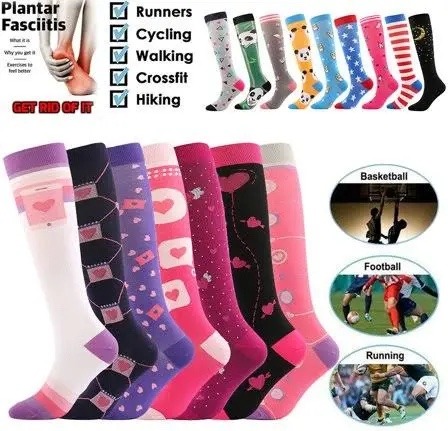
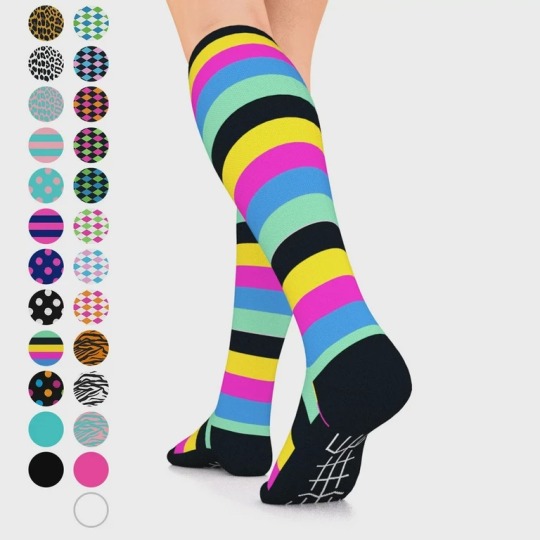

Left | Middle | Right
Toeless & Calf-only
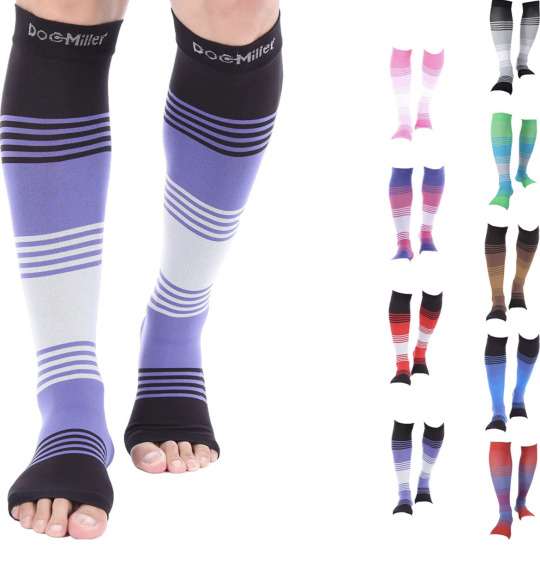

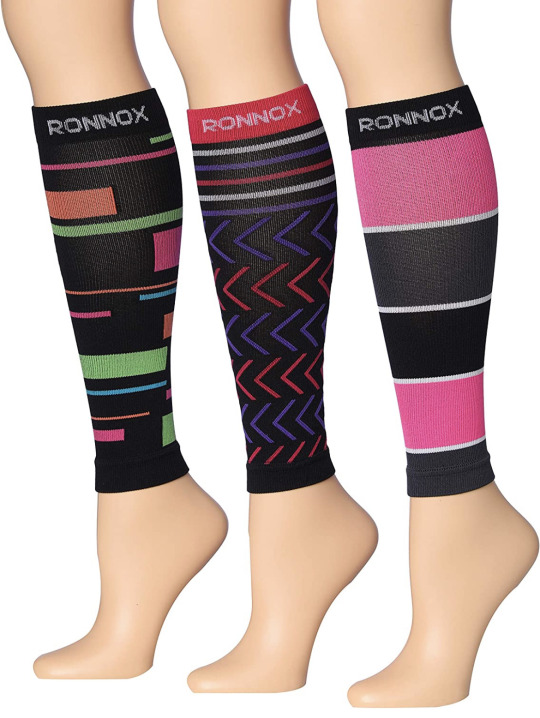
Left | Middle | Right
Quite different than what my old family members use and the hospital versions. The idea of needing them is a little less daunting now
#disability#cpunk#cripple punk#compression socks#vascular#praise be to akeso and panakeia#cpunk fashion
84 notes
·
View notes
Text

3 notes
·
View notes
Text
Understanding the Crucial Link Between Sleep and Vascular Health
In the bustling world of health and wellness, the impact of sleep on vascular health is often overlooked. Yet, emerging research underscores a profound connection between our sleep habits and the health of our blood vessels. Dr. Sumit Kapadia, a renowned and best vascular specialist from Vadodara, highlights this connection, emphasizing the importance of quality sleep in maintaining vascular health and preventing cardiovascular diseases.

The Impact of Sleep on Blood Vessel Function
Sleep influences our health in various ways, but its role in vascular health is particularly significant. Proper sleep helps regulate blood pressure and supports the integrity of the vascular system. Insufficient sleep, on the other hand, can lead to vascular inflammation and a higher risk of hypertension, both of which are precursors to more severe cardiovascular conditions. Also read: 9 steps to enhance sleep quality for vascular health.
How Sleep Affects Our Arteries and Veins
During sleep, critical repair processes occur in the body, including in the vascular system. Blood pressure naturally dips at night, which reduces stress on the arteries and helps maintain their elasticity. Disrupted or inadequate sleep can prevent this natural lowering, leading to sustained high blood pressure and increased strain on arterial walls.
Practical Tips for Enhancing Vascular Health Through Better Sleep
Consistency is Key:
Going to bed and waking up at the same time every day helps regulate your body’s internal clock and improves the quality of your sleep.
Create a Restful Environment:
Ensure your bedroom is conducive to sleep—quiet, dark, and cool are optimal conditions that can help you fall asleep faster and stay asleep longer.
Monitor Your Diet:
Avoid heavy meals and stimulants like caffeine close to bedtime. Opt for a light dinner and consider a soothing herbal tea to ease into sleep mode. 10 Offbeat Foods That Can Boost Your Vascular Health.
Regular Physical Activity:
Engage in moderate exercise regularly, but avoid vigorous workouts close to bedtime. Activities like walking or gentle yoga can improve circulation and help you wind down at the end of the day.
Manage Stress:
Incorporate relaxation techniques such as deep breathing, meditation, or reading into your nightly routine to help calm your mind before bed.
The Role of Professional Guidance
For those with existing vascular health issues or a history of sleep disorders, professional guidance is essential. Dr. Sumit Kapadia, with his expertise in vascular health, provides comprehensive evaluations and tailored advice to optimize both vascular health and sleep quality. Consulting with a specialist like Dr. Kapadia can help you navigate the complexities of vascular health linked to sleep patterns.
Conclusion
The relationship between sleep and vascular health is intricate and significant. By adopting healthy sleep habits, you can enhance your circulatory function and reduce the risk of vascular and cardiovascular diseases. For personalized care and expert advice, consider reaching out to a vascular health specialist.
#varicose veins best doctor#laser varicose veins treatment#endovascular surgery#best treatment for varicose veins#laser treatment for varicose veins#av fistula surgery#Varicose Vein Surgery#Varicose Vein#Swelling In Legs#Vascular Specialist#Varicose Veins Surgeon#Compression Stockings#Varicose Vein Doctors Near Me#Varicose Vein Doctor#Leg Injury
0 notes
Text
Stop ordering crippled autistic faggy trannies to vote between two evil white guys or else we're bad people enabling fascism. It's not going to happen and it won't change a damn thing because fascism has lived here since the dawn of the settler colonial age. Voting doesn't fucking work within this structure - how do you think a dementia afflicted schmuck got into office?? Popular vote didn't want him. Popular vote didn't want Trump either. People of Turtle Island demand the same swiftness it took to ban TikTok to GIVE LAND BACK ENTIRELY, CREATE SOCIAL FINANCIAL ROMANTIC AND SEXUAL EQUITY FOR ALL, AND GIVE GREAT HEALTHCARE NUTRITIOUS FOOD AND COMFORTABLE SHELTER TO ALL. This is step number one. Get with it or hop off it.
Feetnote: I do not give a singular god damn golden silver or copper fuck if you view me as inhuman for my political stance. You already saw me that way baby so go shun somebody who deserves it instead 🥳 Or just save your angry energy and go somewhere remote and take a deep breath and scream as loudly as possible. Just don't involve me!
#op#Joe bidet#tronald dump#two potty system#the ununited police state of hysteria#turtle island#disabled#chronic pain#autistic adult#eds#mals#pots#vascular compression#connective tissue disorder#postural orthostatic tachycardia syndrome#median arcuate ligament syndrome#ehlers danlos syndrome#borderline personality disorder#strong arming
1 note
·
View note
Text
#Varicose Veins Treatment#NAGPUR#Vein Doctor#Vascular Surgeon#Deep Vein Thrombosis#DVT#Best Doctor For Varicose Vein#Varicose Vein Remedies#Sclerotherapy#Endovenous Laser Treatment#Radiofrequency Ablation#Compression Stockings#Venous Insufficiency#Spider Veins#Venous Ulcers#Vein Stripping#Varicose Vein Surgery#Non invasive Treatment#Minimally Invasive Treatment#Pain Management
0 notes
Text
Happy New Year!
Let's imagine it was the Earth itself that was going into its 2024th year. That is to say, we're compressing the entire history of the Earth into just the past 2023 years. What events would have happened when?
Well, not too much is certain about the first couple decades after our planet formed, until around 50 CE when we were hit by another proto-planet, Theia, and the debris formed the Moon. After a couple years of the planet cooling down again, the oceans formed out of boiling rain. The timing of the origin of life is very uncertain, but there are chemical signs it may very well have happened as early as the second century. Around 200 CE, the gas giants did a big funky orbit-swapping dance, and in the process inflicted the Late Heavy Bombardment on the rest of the solar system, meaning the Earth was suffering a ton of meteorite strikes for the entire third century.
The first indisputable evidence of life is from around 330, and the first stromatolites appear around 470. Those are basically the first fossils, stones created by layer upon layer of oxygen-producing cyanobacteria living and dying on top of one another. But even with oxygen producers evolving, it would take many centuries before oxygen became a major part of the atmosphere: not until the Great Oxygenation Event, which happened during the ninth and tenth centuries. That's also about the time the first complex, eukaryotic cells evolved through a symbiosis between an anaerobic archaean and an oxygen-breathing bacterium. The bacterium became more and more focused on just the oxygen-breathing task inside the larger cell, until its descendants were mitochondria, which as you all know are the powerhouse of the cell. The next seven centuries passed by with only slow, gradual changes, and life continuing to be unicellular and difficult to find in the fossil record.

(1735's Snowball Earth, by me)
From 1704 to 1730, the entire planet froze over. After merely two years of thaw, it happened again, this time lasting from 1732 to 1742. But these snowball Earth episodes set the stage for the evolution of animals that began right after. Across the mid-18th century, the bizarre Ediacaran biota, with its strange symmetries, fronds, and fractal-like pattern filled the oceans. In the early 1780s they went extinct, possibly due to a temporary drop in oxygen-levels, only to be replaced by a great variety of quite different creatures in the Cambrian Explosion.
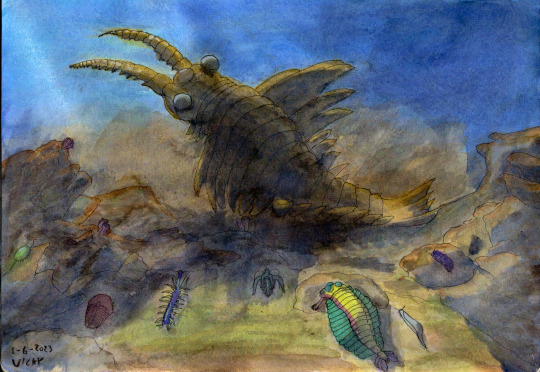
(Class of 1799, by me)
Starting in 1784 and running for a few decades, the Cambrian period saw the origin of most of the modern animal phyla, reaching its most famous form in the Burgess Shale fauna of 1799. During this time, most animals still lived on the sea floor, either attached or crawling, with relatively few actually swimming creatures. Plants started tentatively moving onto land around 1817, and in 1825, the rising of the great Appalachian mountains caused a severe drop in global CO2 and thus temperatures, leading to the Late Ordovician mass extinction.

(Horseshoe crabs and sea scorpions on a beach in 1834, by me)
Bony fish first showed up during the 1830s, and around the same time plants were getting serious about inhabiting the land, evolving roots and vascular tissues so they could properly grow there. Millipedes and the ancestors of spiders were the first animals to follow them onto land. Our own fishy ancestors did not take their first step until 1857, by which point the arthropods were well established there and the plants had figured out how to become trees. The Late Devonian extinction, partially caused by the evolution of said trees and partially by the south pole freezing, played out in two pulses over the late 1850s and early 1860s.
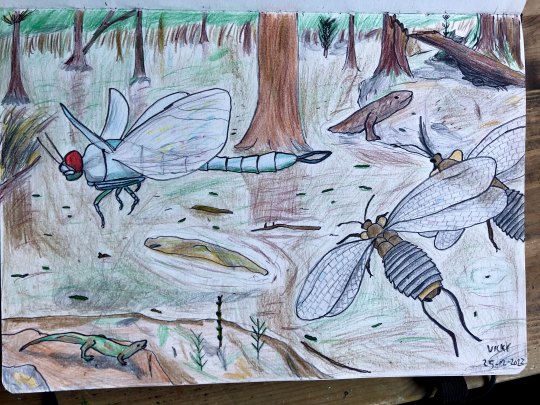
(Swamp prominently featuring Meganeura and Mazothairos in 1889, by me)
Arthropods and vertebrates continued to gain adaptations to life on land. The insects became the first creatures ever to fly in 1878, and the high-oxygen atmosphere of the time would be especially good to them. Around 1884, a group of vertebrates called the amniotes, after the membrane that kept water inside their eggs so they could lay them on land without them drying out, split into two groups: the reptiles and the synapsids (which we mammals descend from). The next few decades would see the synapsids in particular being extremely successful as the supercontinent Pangaea formed. Until 1912, when a massive episode of volcanism caused the worst mass extinction of all time, the Great Dying, scouring the Earth of a huge portion of its life.
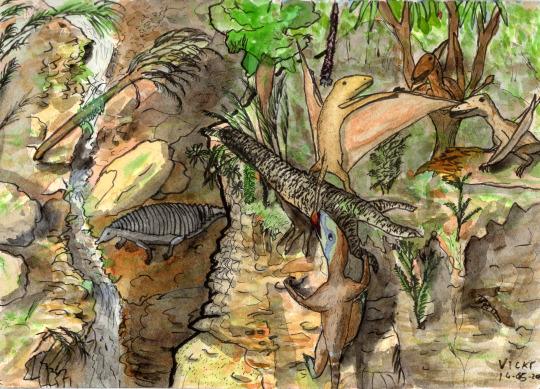
(A 1930 scene featuring the three branches of archosaur: dinosaur, pterosaur, and pseudosuchian, by me)
The 1910s were a period of slow recovery during which strange new forms of animal evolved. Many different, unrelated reptiles, such as the ichtyosaurs and plesiosaurs, went to sea, where they would continue to provide some of the most impressive creatures for most of the 20th century. On land, the dinosaurs first appeared in 1920, though for the next decade or so they'd live in the shadow of their pseudosuchian (crocodile-line) cousins. In 1934, Pangaea began to break up, resulting in another terrible pulse of volcanism that caused a lot of extinctions and left particularly the feathered and furry survivors with a lot of empty niches to fill, allowing the dinosaurs and mammals to diversify greatly. The last common ancestor of all modern mammals lived in the early 1940s, and by 1957 the dinosaurs had figured out flight, with Archaeopteryx usually being considered the first bird. Other dinosaurs took on an incredible variety of sizes, shapes, and forms. Some of the most famous ones include Dilophosaurus (1942), Diplodocus and Stegosaurus (1955), Iguanodon (1969), Velociraptor (1991), and Tyrannosaurus rex (1994).

(A tropical lakeside in the year 2000, by me)
In 1995, the world was struck by a meteorite, wiping out many groups, including the marine reptiles, pterosaurs, and ammonites. The surviving mammals and dinosaurs went on to diversify across the next couple of years and had formed thriving new ecosystems in the tropical world of the turn of the millennium. The first known bat lived in 2001, and the whales returned to the oceans next year. Around 2009, the world's climates turned colder and dryer. Antarctica froze over and grasslands spread widely. Our last common ancestor with the chimpanzees and bonobos lived in 2021, and by new year 2023, our ancestors were getting brainier and more proficient with tools. That's also when the north pole froze and the Quaternary ice age cycle began. The first known members of Homo sapiens lived on 10 November 2023. The latest ice age started on 14 December, and ended at 2 AM on 30 December. The great pyramid of Giza was built at 6 AM on 31 December and On The Origin Of Species was published at 23:22 PM.
#palaeoblr#happy new year#2024#geologic timescale#vicky's vritings#one year is 2.244 million years if you're curious#and yes i did exclude both year 0 and 2024#since 0 doesn't exist and 2024 hasn't happened yet#my art#i rather enjoy having an extensive collection of my art to illustrate my paleorambles nowadays#incidentally the big bang occurred in 4121 bce at this scale#which is curiously close to the date of creation creationists made up#if only they would follow through and insist humanity itself was seven weeks old too
124 notes
·
View notes
Text
I was right. On my ultrasound they found out that my superior mesenteric artery is tortuous (twisted) and narrowed, and my celiac artery is also narrowed. This is causing lack of blood flow to my organs and all of the symptoms I’ve been having for three years.
It took one doctor to believe me, and then one test to confirm. I want to feel happy but I can’t, not fully, because I knew it would take so little to confirm or deny my suspicions— yet all the doctors previously didn’t believe me, and the last GI doctor laughed at me and said “[a vascular compression syndrome] is a zebra in a field of horses”.
I was right, and it almost fucking killed me to get this test because of all the other useless doctors who couldn’t set aside their egos.
#personal#chronic pain#no longer undiagnosed#chronic illness#disabled#cripple punk#ehlers danlos syndrome#chronically ill#important#war is not over
57 notes
·
View notes
Text
Home Nursing Advice Column #2: Tracking and Treating Small Skin Infections
Small skin infections occur when bacteria enter the body through a cut or nick in the skin. As the bacteria multiply, the body's immune system responds, causing the area to become hot, swollen, red and painful. This response encourages blood flow through the area, bringing bacteria-fighting white blood cells and carrying away dead bacteria and other waste.
You can tell whether you need to see a doctor about this infection by tracking how quickly it spreads through the skin. Do this by drawing an outline around the reddened area. The line should be tight against the edge of the infection so you can see if the infection gets bigger or changes shape.
If the redness spreads rapidly (if you can see a significant difference within about an hour), call a doctor, as this might require antibiotics to treat. Other reasons you might want to see a doctor is if there is a pocket of pus below the site of infection, you have diabetes or vascular problems, or if the area is more than 2 inches across.
If the infection is spreading very slowly or while waiting for a doctor to call you back, you can help the process along and speed up healing by using hot, moist compresses.
Take 2-3 cotton washcloths or rags and put them in a pan of tap water. Heat the water on a stovetop to about 107-110 degrees F. Take the first cloth out, wring the excess water out of it, fold it, and press it against the site of infection. It should be uncomfortably hot, maybe somewhat painful, but it should not burn you.
Every minute or so, put the first cloth back in the water, and take the next cloth out, wring it out, fold it, and place on the infection. Repeat for 20-30 minutes, then allow the site to go back to it's normal temperature.
Do this every 2-3 hours while awake. Right before each session, draw your outline of the reddened area the same way you did initially. You should start to see the red area shrink. If you don't see any change within a day, call a doctor.
97 notes
·
View notes
Text
What's going on with Nemona's wrist?
this is mostly just me putting down all my thoughts about this hc I have. Below the cut bc it's long as usual but read on if ur interested in like. orthopedics
I think Nemona has fatigue and some kind of wrist Issue because
1. She implies she has decreased motor function in that arm (can't throw pokeballs well, supports her arm with her other hand during battles)
2. She wears a brace
3. She gets winded easily / needs to catch her breath more than other characters / hates stairs
So that got me wondering what the cause could be. I work in an orthopedic office and my shifts are 12 hours so sometimes when it's slow and I'm bored this is what my mind wanders to
Option 1: It's carpal tunnel and she's out of shape
This is the most obvious answer since carpal tunnel is a repetitive stress injury and she's wearing a brace that looks almost identical to irl braces for that problem. Throwing pokeballs over and over, especially incorrectly, would be the most likely cause of an asymmetrical injury like that, and is actually reasonable for someone of her age and activity level. The winded thing is just because she's out of shape and has no underlying cause. Or maybe she just has some kinda chronic pain / fatigue disorder. That's not my department idk
Option 2: Oligoarticular JIA (juvenile idiopathic arthritis)
This very long name is just describing chronic joint swelling in children that affects less than 5 joints. It's an autoimmune disease, and actually not that uncommon all things considered. It causes stiffness and pain, which would explain the stamina issues and motor skill issues. Plus, the constant flexion and extension of the knees from staircases certainly would explain her distaste for them in particular. That shit hurts. Occasionally people will use a brace for JIA-- it's highly unlikely her wrist would be the worst considering the typical presentation patterns (it usually affects bigger joints first like the knees) but hey. It's possible! This condition also affects young girls more often than other groups so. Math checks out
Option 3: Ehlers-Danlos Syndrome (hypermobility type)
Figured I would include this bc I've seen a few people hc this and wanted to give it a fair shot myself. This is a heritable connective tissue disorder that causes hypermobile joints, chronic pain, fatigue, and a whole host of other things. Specifically tho, this disorder used to be called EDS type III and is now considered part of the Hypermobility Spectrum Disorders, but that's a can of worms for a post that's not this one. While the symptoms do match, and honestly quite well (a brace for stabilization makes perfect sense and the fatigue symptoms feel pretty on the nose) the disease usually causes very stretchy skin and vascular issues that she doesn't seem to have so I'm a tad on the fence
Option 4: Cervical spinal stenosis
Despite this being the first thing that came to mind for me (since I see it a lot in the office) I'm now less convinced this would be the case. This disorder is basically a narrowing of the spinal canal that pinches the nerves in the neck. It can cause pain, weakness, numbing, and pain that radiates down the body. If most of the compression was on the C4 and C5 nerve I can see it affecting one arm / wrist especially rough (since the pain is typically bilateral but asymmetrical) but also this occurring in people under the age of 50 is SUPER rare so eh. It's possible it was congenital or caused by an injury but I wouldn't bet on it. As for the stamina issues, the neurological issues caused by the compression would likely be the cause of that, especially radiating down the back and legs. Felt worth it to include even if I'm not 100% convinced
I'm saying "options" here bc these symptoms are super vague and there's like 80 billion things that could cause it, I'm just racking my brain for different possibilities. If anyone has other hcs for the underlying causes of Her Whole Deal lmk I'm curious
#i know this is completely deranged but it's pride month let me have this#nemona#pokemon sv#headcanons#mod vex
150 notes
·
View notes
Text
[malnutrition, food, medical diet, weight discussion]
My entire body hurts so bad today and I am so exhausted despite having like 10 hours of sleep. My body and nervous system are so overwhelmed from malnutrition on top of my usual complex chronic illness stuff and it is seriously difficult to come out of it. The intense fight or flight response that I’ve been in for months feels never ending and nothing has really been able to calm me down. I was always aware of physical effects of malnutrition, but my level or anxiety is higher than I’ve ever experienced and my dissociation threshold feels nonexistent. And the worst part is knowing that food will help, but if I overdo it I’ll end up in the hospital again with significantly worse symptoms.
I’ve unintentionally lost so much weight over the past few months because I haven’t been able to eat normally and I don’t tolerate my Soylent meal replacement shakes anymore. It’s quite scary watching my body change like it is and that definitely confounds my anxiety. I’m really glad my pcp was able to get me a prescription for a meal replacement shake because I really don’t want a feeding tube and am doing everything that I can to avoid one. I just really miss food and making meals, which is making my medical diet more difficult. (It helps knowing I absolutely can not tolerate the pizza I really want, but it’s just hard restricting myself so much).
And it’s so fucking difficult to actually hydrate myself and stay hydrated even *with* IV hydration. I am really so miserable and in so much pain and so nauseous.
#cw food#cw weight#cw medical diet#cw malnutrition#Olive’s medical updates#olive blogs#disability#I really just want to eat food so badly#but my gastroparesis keeps telling me no#malnutrition recovery is honestly so difficult and so slow#but I know it can’t be faster#ugh#abdominal vascular compression syndromes#SMAS#MALS#nutcracker syndrome#gastroparesis#endometriosis#and I’ve also been very heavily dissociated for months my#osddid#signed: kim & olive & ann
4 notes
·
View notes
Note
with their superior vascular system, can gallifreyans still get pins and needles from reduced blood flow, like humans do?
Pins and Needles
Paraesthesia, or pins and needles, occurs when pressure is applied to a nerve, usually due to restricted blood flow. It's the sensation that kicks in when a nerve - having been compressed - suddenly 'wakes up' as blood flow is restored. It's like your friend dozing off at a party (the numbness) and then protesting when you try and stuff them in a taxi (the paraesthesia).
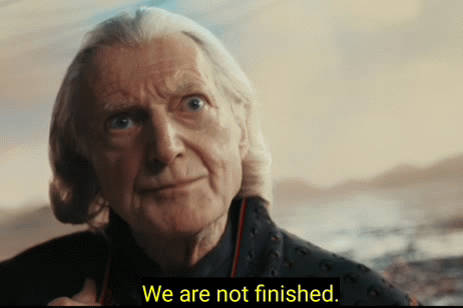
👽The Nerve of It All
Gallifreyans, on the other hand, boast a vascular system that makes human arteries look like amateur hour. They have blood pressure levels sitting around 180/120 on average, and can also control their blood vessel dilation like tuning a guitar. However, this doesn't give them immunity from pins and needles.
In humans, paraesthesia is often a result of pressure on peripheral nerves, and for Gallifreyans, the story isn't all that different. Nerve compression followed by reperfusion leads to a burst of nerve signals as the nerve 'wakes up'. Even with their superior blood flow, a Gallifreyan nerve under pressure can behave similarly. The difference lies in the causes.
🌟Varied Causes in Gallifreyan Biology
Significant Physical Pressure: Just like humans, if they sit weirdly for too long they're going to feel it.
Self-Induced Temporary Ischemia: As part of their unique healing processes, Gallifreyans might deliberately restrict blood supply (ischemia), leading to paraesthesia during scenarios such as post-regeneration periods or during a healing coma.
Insufficient Blood Pressure for Dual Hearts: Paraesthesia can occur if blood pressure is inadequate to support the two hearts over extended periods, like trying to run two engines on half a tank.
Severe Bone Fractures: Paraesthesia may arise from damage to medullary arteries in cases of significant bone fractures. Major tingles.
Severe Injuries with Major Blood Loss: Injuries leading to substantial blood loss can also trigger paraesthesia, due to the impact on overall blood circulation and nerve function. Massive tingles (though you're probably more concerned about the blood).
🏫 So ...
While Gallifreyans rock their advanced vascular system, they are still subject to the whims of their nerves. The sensation of pins and needles, triggered by a wider range of causes, is more of a red flag for Gallifreyans than in humans, indicating a potentially serious internal problem. Or then again, they may have just tied that Converse a little too tight. Jury's out.
Hope that helped! 😃
→🫀Gallifreyan Anatomy and Physiology Guide (WIP)
→⚕️Gallifreyan Emergency Medicine/Monitoring Guides
→📝Source list (WIP)
-------------------------------------------------------
》📫Got a question / submission?
》😆Jokes |🫀Biology |🗨️Language |🕰️Throwbacks |🤓Facts
》📚Complete list of Q+A
》📜Masterpost
If you like what GIL does, please consider buying a coffee or tipping below to help make future projects, including complete biology and language guides.
#doctor who#gil#gallifrey institute for learning#dr who#dw eu#gallifrey#gallifreyan biology#gil biology#time lord biology#gallifreyans#ask answered#ajax0404
29 notes
·
View notes
Text
Anyone have pros n cons of mobility aid? Try to find if i should use crutches or some other thing. Ps i have pain and fadigue and it affects mostly my legs and arms (and also my tired lil brain bt that's not the point) so i think that might be important to know? Since i have force my arms to use crutches yk
Theres a lot of things i can use, heard about compression socks too, i might use that but idk :p
ps i don't know much about mobility aids that's why I'm asking for advice, please don't be mean :')
EDIT: I SHOULD'VE SAID THIS BEFORE BUT I MENTIONED COMPRESSION SOCKS BECAUSE MY PAINS MIGHT BE VASCULAR SOOOOO YEA THATTHE CURRENT SUSPICION
13 notes
·
View notes
Text

Vascular health isn't just about the heart! It encompasses your entire circulatory system, including arteries, veins, and lymphatic vessels. Conditions like PAD and DVT can impact various parts of your body beyond the heart. Let's widen our perspective and prioritize holistic vascular wellness for overall health and vitality.
#varicose veins best doctor#laser varicose veins treatment#endovascular surgery#best treatment for varicose veins#laser treatment for varicose veins#av fistula surgery#Varicose Vein Surgery#Varicose Vein#Swelling In Legs#Vascular Specialist#Varicose Veins Surgeon#Compression Stockings#Varicose Vein Doctors Near Me#Varicose Vein Doctor#Leg Injury
0 notes
Text
so for anyone who's missed this convo since it's still relatively fresh even for me:
I spent over a decade searching for answers to my gastrointestinal pain & dozens of other symptoms only to be dismissed time and time again.
I finally got diagnosed when my gastro said "your GI stuff keeps coming back normal, but has anyone looked at your veins yet?" I was ultimately referred to a vascular surgeon and diagnosed with MALS, something I had never heard of in my decade of research and being a guinea pig.
If you have chronic, debilitating symptoms that seem to revolve heavily around your stomach and guts, but that doesn't actually show up on any testing, look into vascular compressions. (MALS, NCS, and SMAS are 3 that I know of.)
Yeah so it turns out all of your organs need blood to work properly, and when they aren't getting enough, a lot of weird stuff can happen. It's considered rare and is very poorly understood, but a lot of MALS patients were at the end of our ropes after years of being told it was all in our heads, only to find out, no, actually, my stomach is having what is effectively a heart attack when I try to eat- however technically speaking my stomach isn't the issue, it's the blood flow to it.
don't give up on answers just because they aren't readily available. I shouldn't have had to wait 10 years, but it's still worth it after all this time to know for sure, and to have some idea of how to prepare for the future. the human body is exceptionally complex and weird and so is the world we live in, a lot of things can go wrong with a body and we don't even know all of them yet.
11 notes
·
View notes
Text
#Varicose veins treatment in NAGPUR#Varicose veins in NAGPUR#Vein Doctor in NAGPUR#Vascular surgeon in NAGPUR#Deep vein Thrombosis ( DVT ) in NAGPUR#Best Doctor for varicose vein in NAGPUR#Varicose Veins Treatment#NAGPUR#Vein Doctor#Vascular Surgeon#Deep Vein Thrombosis#DVT#Best Doctor For Varicose Vein#Varicose Vein Remedies#Sclerotherapy#Endovenous Laser Treatment#Radiofrequency Ablation#Compression Stockings#Venous Insufficiency#Spider Veins#Venous Ulcers#Vein Stripping#Varicose Vein Surgery#Non invasive Treatment#Minimally Invasive Treatment#Pain Management#Leg Swelling#Leg Pain#Leg Cramps#Leg Fatigue
0 notes